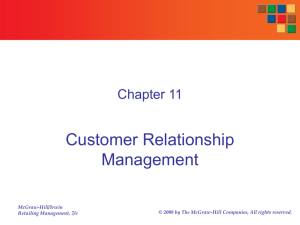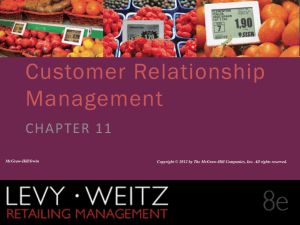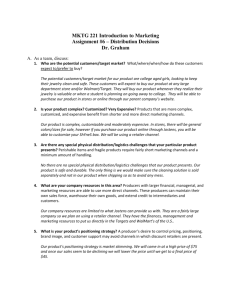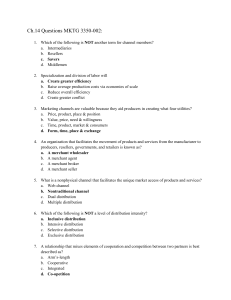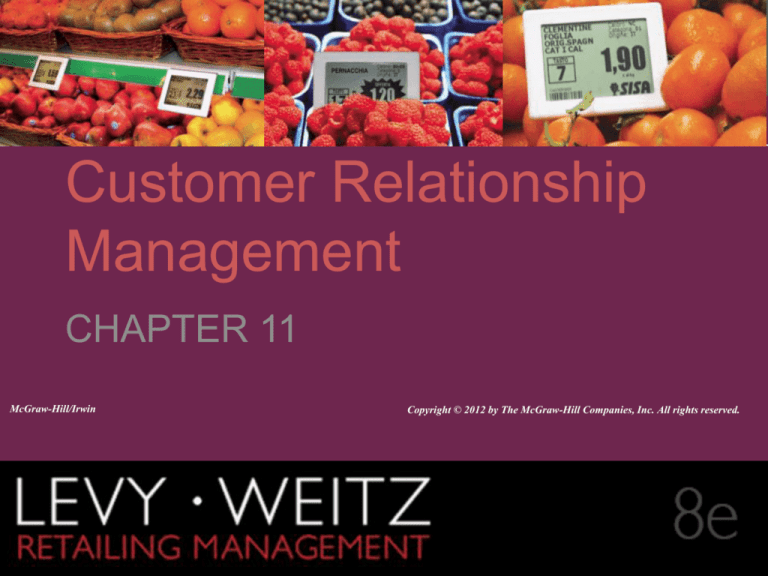
CHAPTER
CHAPTER 11
2
1
Customer Relationship
Management
CHAPTER 11
McGraw-Hill/Irwin
Retailing Management 8e
Copyright © 2012 by The McGraw-Hill Companies, Inc. All rights reserved.
© The McGraw-Hill Companies, All rights reserved.
11 -
Customer Relationship
Management (CRM)
CHAPTER
CHAPTER 11
2
1
• A business philosophy and set of strategies, programs, and
systems that focus on identifying and building loyalty with a
retailer’s most valuable customers.
• All customers are not equally profitable, and more or less
profitable customers need to be treated differently
• Retailers now concentrate on providing more value to their
best customers using targeted promotions and services to
increase their share of wallet – the percentage of the
customers’ purchases made from the retailer
11 -
Customer Loyalty
CHAPTER
CHAPTER 11
2
1
• Committed to purchasing merchandise and
services from a retailer
• Resist efforts of competitors to attract the loyal
customer
• Emotional attachment to retailer
• Personal attention
• Memorable positive experiences
• Brand building communications programs
11 -
Can Offering Price Discounts Achieve
Customer Loyalty?
CHAPTER
CHAPTER 11
2
1
No!
Retail strategies like these
can be copied by competitors
These strategies encourage
customers to be always
looking for the best deal rather
than developing a relationship
with a retailer
McGraw-Hill Companies, Inc./Gary He, photographer
11 -
The CRM Process
CHAPTER
CHAPTER 11
2
1
CRM is an iterative process that turns customer data
into customer loyalty through four activities:
1. Collecting customer data
2. Analyzing the customer data and identifying target
customers
3. Developing CRM programs
4. Implementing CRM programs
11 -
CRM Process Cycle
CHAPTER
CHAPTER 11
2
1
11 -
Collecting Customer Data:
Customer Database
CHAPTER
CHAPTER 11
2
1
• Transactions – a complete history of purchases
• Purchase date, price paid, SKUs bought, whether or not
the purchase was stimulated by a promotion
• Customer contacts by retailer (touch points) --visits
to web site, inquires to call center, direct mail sent
to customer
• Customer preferences
• Descriptive information about customer
• Demographic and psychographic data
• Customer’s responses to marketing activities
11 -
Collecting Customer Data:
Identifying Information
CHAPTER
CHAPTER 11
2
1
Approaches that store-based retailers use:
• Asking for identifying information
• Telephone number, name and address
• Offering frequent shopper cards
• Loyalty programs that identify and provide
rewards to customers who patronize a retailer
• Private label credit card (that has the store’s
name on it)
• Connecting Internet purchasing data with the
stores
11 -
Heighten Privacy Concerns
When Using Electronic Channel
CHAPTER
CHAPTER 11
2
1
• Information collected
without the awareness of
customers
• Collecting click stream
data using cookies
Similar to an invisible person
videotaping a customer as
they walk through a store
Stockbyte/Punchstock Images
11 -
Customer’s Decision to
Offer Information
CHAPTER
CHAPTER 11
2
1
11 -
Protecting Customer Privacy:
Differences between U.S. and EU
United States
• Limited protection in specific
areas
•
•
•
•
Credit reporting
Video rentals
Banking
Medical records
• Opt out: Consumers must
explicitly tell retailers not to use
their personal information
CHAPTER
CHAPTER 11
2
1
European Union
• Stringent consumer privacy laws
• Information only can be collected for
specific purposes
• Purpose must be disclosed to customer
• Information can only be used for specific
purpose
• Information cannot be exported to
countries with less stringent regulations
• Opt in: Consumers own their
personal information, and retailers
must get consumers to explicitly
agree to share this personal
information
11 -
Market Basket Analysis
CHAPTER
CHAPTER 11
2
1
Data analysis focusing upon the
composition of the customer’s
market basket – what items are
bought during a single shopping
occasion
Uses:
• Adjacencies for displaying
merchandise
• Joint promotions
• Bananas in the cereal aisle as well as
in the produce section
• Beer with baby dippers
• Tissues with cold medicine
Burke/Triolo Productions/Getty Images
11 -
Market Basket Analysis Taught
Wal-Mart to Change!
Product
Bananas
Kleenex
CHAPTER
CHAPTER 11
2
1
Placed Near
cornflakes, produce
paper goods, cold medicine
Measuring spoons
housewares, Crisco shortening
Flashlights
hardware, Halloween costumes
Little Debbie snack cakes
Bug spray
coffee
hunting gear
11 -
Identifying Best Customers
CHAPTER
CHAPTER 11
2
1
• Estimating Lifetime Value (LTV)
• The expected contribution from the
customer to the retailer’s profits over his
or her entire relationship with the retailer
• Use past behaviors to forecast future
purchases, the gross margin from
these purchases, and the costs
associated with serving the
customers
• Classifying Customers by recency,
frequency, and monetary value of
purchases (RFM Analysis)
(c) Brand X Pictures/PunchStock
11 -
Which Customer Probably Has
the Greatest Lifetime Value
CHAPTER
CHAPTER 11
2
1
Purchases Over Last 10 Weeks
11 -
Customer Pyramid
CHAPTER
CHAPTER 11
2
1
Platinum
Best
Most loyal
Least price sensitive
80-20 rule:
80% of sales or profits come from
20% of the customers
11 -
Customer Retention
CHAPTER
CHAPTER 11
2
1
• Frequent Shopper
Programs
• Special Customer
Services
• Personalization
• 1-to1 Retailing
• Community
Royalty-Free/CORBIS
11 -
Elements in Effective
Frequent Shopper Programs
CHAPTER
CHAPTER 11
2
1
• Tiered rewards based on customer value
• Offer choices of rewards
• No all customers value the same rewards
• Non-monetary incentives, altruistic rewards
• Reward all transactions to ensure the collection of
all customer transaction data and encourage
repeat purchases
• Transparent and simple so that customers easily
understand when they will receive rewards
11 -
Personalization
CHAPTER
CHAPTER 11
2
1
11 -
Dealing with Unprofitable
Customers
CHAPTER
CHAPTER 11
2
1
• Offer less costly
approaches for
dealing with these
customers
• Charge customers
for extra services
demanded
Don Farrall/Getty Images
11 -
Implementing CRM Programs
CHAPTER
CHAPTER 11
2
1
• More than CRM management, computer systems,
and communication about the importance of
customers.
• In addition…..
• Close coordination between departments –
Marketing, MIS, Operations, HR
• Shift in orientation
• Product Centric
• Customer Centric
11 -
Keywords
CHAPTER
CHAPTER 11
2
1
• RFM (recency, frequency, monetary) analysis
Often used by catalog retailers and direct
marketers, a scheme for segmenting customers on
the basis of how recently they have made a
purchase, how frequently they make purchases,
and how much they have bought.
• frequent-shopper program A reward and
communication program used by a retailer to
encourage continued purchases from the retailer’s
best customers.
• 1-to-1 retailing Developing retail programs for
11 -


